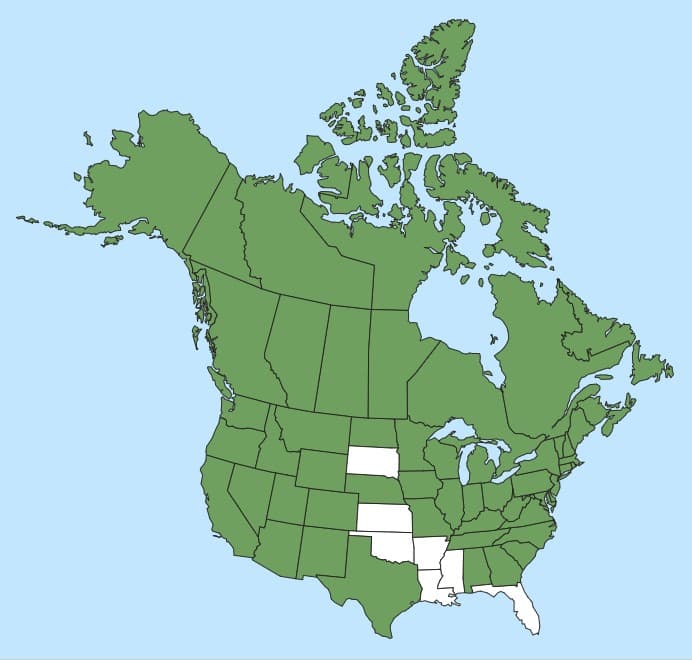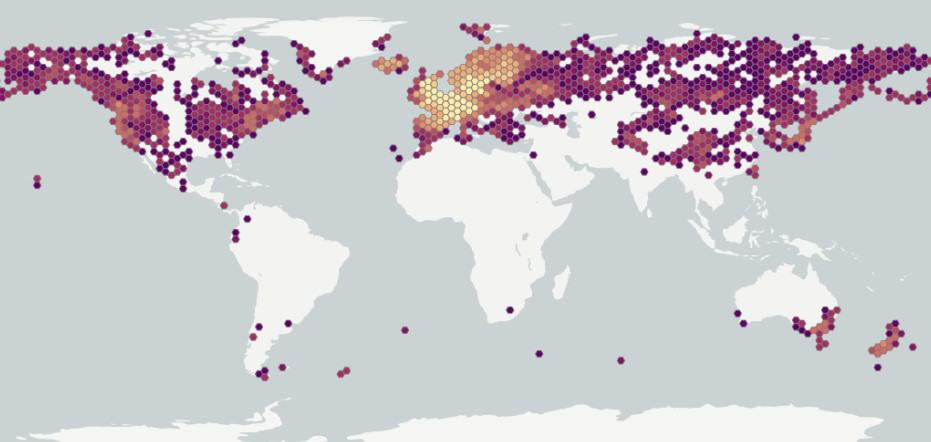Festuca rubra
Explore More :
Explore plus :
Overview
Aperçu
Regulation :
Remarques Réglementation:
Regulation Notes:
Distribution :
Répartition :
Festuca rubra is native to subarctic and temperate regions of Asia, Europe and North America and has been introduced and become naturalized in elsewhere (USDA-ARS 2022).
Habitat and Crop Association :
Habitat et Cultures Associées :
Native Festuca rubra grows in meadows, pastures, dry light wooded areas, sandbanks, and embankments (Bojňanský and Fargašová 2007).
Economic Use, cultivation area, and Weed Association :
Utilisation économique, zone de culture et association de mauvaises herbes :
Festuca rubra is a cool season, perennial, sod-forming grass planted for lawns, general purpose turf, and as a soil binder for erosion control (Alderson and Sharp 1995; Barkworth et al. 2007). This species grows over a wide range of soil types and is shade tolerant (Alderson and Sharp 1995).
Weed species of primary concern in Oregon F. rubra seed production fields include Bromus tectorum (downy brome), Poa annua (annual bluegrass), and Vulpia myuros (rattail fescue) (Alderman et al. 2011).
Duration of Life Cycle :
Durée du cycle vital:
Perennial
Dispersal Unit Type :
Type d’unité de dispersion :
Floret
General Information
RENSEIGNEMENTS GÉNÉRAUX
Festuca rubra belongs to a group of Festuca species generally referred to as fine fescues sold for used in turfgrass systems under a variety of environmental conditions (Braun et al. 2020). The Festuca rubra complex is comprised of at least ten subspecies (Barkworth et al. 2007), of which three subspecies are not only found in their native ranges but are also grown commercially for lawn, turf, and erosion control (Alderson and Sharp 1995; Barkworth et al. 2007; Braun et al. 2020). Commercially developed fine fescue varieties of F. rubra subsp. rubra and F. rubra subsp. littoralis are sold under the common names of red fescue or creeping red fescue, and varieties of F. rubra subsp. commutata are sold under the common name of Chewings fescue (Alderson and Sharp 1995; Braun et al. 2020; AOSA 2022; USDA-AMS 2022). Overlapping morphological characters in florets and caryopses among these three subspecies of Festuca rubra can make identification difficult (Musil 1963).
Other species of fine fescues that are sold in commercial channels include Festuca filiformis, F. heterophylla, F. ovina, and F. trachyphylla. These species have similar looking florets and caryopses when compared to F. rubra.
.Identification
Identification
-
Spikelet
Size
- Spikelet length: 6 – 14.5 mm (Tutin et al. 1980; Barkworth et al. 2007; eFloras 2022).
Spikelet size from literature:
- Spikelet length 7-10 mm long (Tutin et al. 1980).
- Spikelet length 9 – 14.5 mm (Barkworth et al. 2007).
- Spikelet length 6 – 13 mm (eFloras 2022).
Shape
- Spikelet oval to egg-shaped.
Surface Texture
- Surface usually smooth, sometimes with hairs near tip.
Colour
- Spikelet color bright green or glaucous (dull greyish-green or blue), but rarely pruinose (covered with white powdery granules) (Tutin et al. 1980).
Other Features
Spikelet composition
- Spikelet composed of 3 – 8 similar looking florets with distal (furthest from the glumes) floret usually sterile and slightly smaller in size (Barkworth et al. 2007; eFloras 2022).
Spikelet composition from literature:
- Spikelet with 5 – 8 florets (Barkworth et al. 2007).
- Spikelet with 3 – 6 florets (eFloras 2022).
Glumes
- Glumes narrowly teardrop-shaped (lanceolate).
- Lower glume length 2 – 4.5 mm.**
- Upper glume length: 3.5 – 6.4 mm.**
**Note: glume length based on literature sources (Barkworth et al. 2007; eFloras 2022).
Glume measurements from literature:
- Lower glume length: 3 – 4.5 mm; upper glume length: 4 – 6.4 mm (Barkworth et al. 2007).
- Lower glume length: 2 – 3.5 (4.5) mm; upper glume length 3.5 – 5.5 (6) mm (eFloras 2022).
Spikelet Disarticulation
- Disarticulation of the spikelet occurs generally above the glumes and between the florets at the rachilla nodes.
-
Floret
Size
- Floret length*: 3.4 – 7.7 mm (average 5.3 mm); width*: 0.7 – 1.3 mm (1.0 mm).
- Rachilla length*: 0.7 – 2.0 mm (average 1.2 mm).
- Awn length*: 0.3 – 2.9 mm (average 1.5 mm).
*Note: minimum and maximum based on a combined five samples with a random selection of 60 florets in normal range of this species using image measurement protocol (ISMA 2020). CDA-S-23411, CDA-S-23396, CDA-S-23410, CDA-S-23387, CDA-S-57406
Size measurements from literature:
- Lemma length: 4 – 9 mm; width: 1.9 – 2.3 mm; awn variable, but not more than one-half as long as lemma (Tutin et al. 1980).
- Lemma length: (4)6 – 7.5(8) mm; awn length: 0.6 – 3.2 (4) mm (Barkworth et al. 2007).
- Floret length: 5.5 – 6.5 mm; width: 0.8 – 1.2 mm (Bojňanský and Fargašová 2007).
- Lemma length: 4 – 6 mm; awn length: 1 – 3.5 mm (eFloras 2022).
Shape
- Floret narrowly teardrop-shaped, widest near mid-point, dorsal-ventrally compressed to slightly in-rolled forming a longitudinal depression of the palea of the lower half of the floret, lemma not keeled.
Surface Texture
- Lemma and palea papery.
Colour
- Floret light yellow to light brown or greyish in colour with green or reddish-purple tinge.
Other Features
Lemma
- Lemma tapering to a narrow point and extending into an awn.
- Lemma wrapping around to partially cover margins of the palea but leaving palea keels mostly exposed.
- Lemma finely granular, hairless or with short stiff hairs, especially in the upper half or near the tip.
Awn
- Awned from tip of lemma; straight.
Callus
- Callus is blunt with a thick rounded ridge on the lemma side.
Rachilla
- Rachilla is straight, slender, round in cross-section with flared disk at tip, may be covered with short hairs.
Palea
- The palea slightly shorter than or equal to length of lemma.
- Palea keels two.
- Palea keel hairs short and stiff (palea teeth).
- Palea surface granular with tuft of short soft hairs near apex.
- Palea semi-transparent and the dark caryopsis is visible behind the palea.
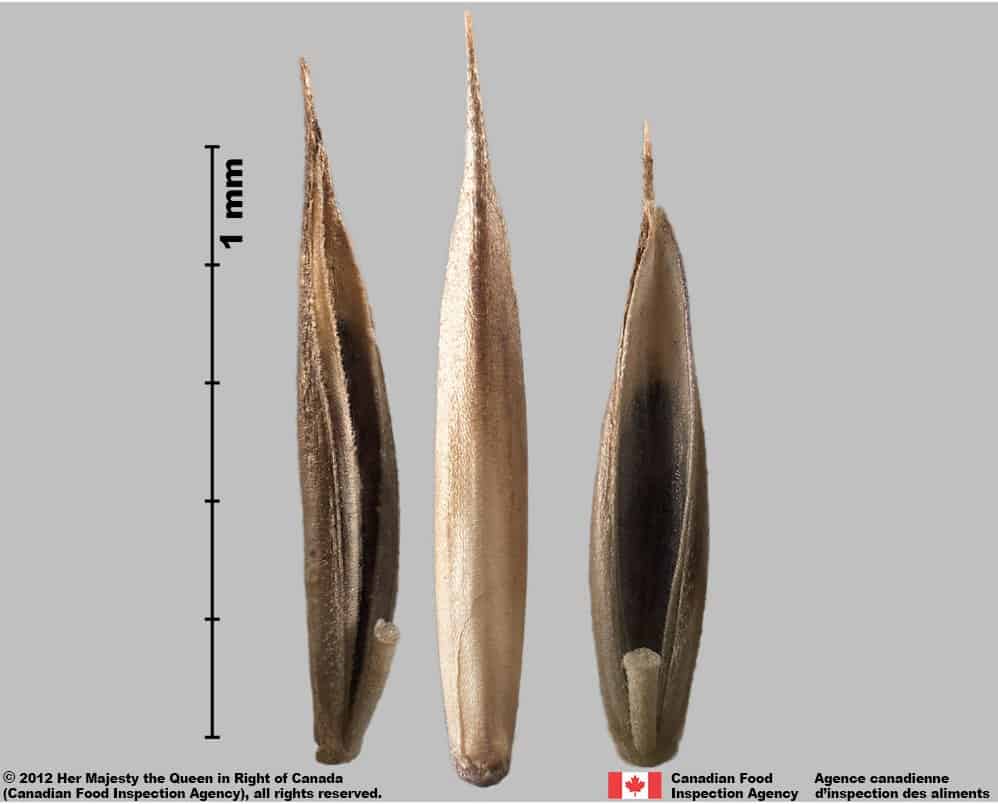
Red fescue (Festuca rubra subsp. rubra) florets

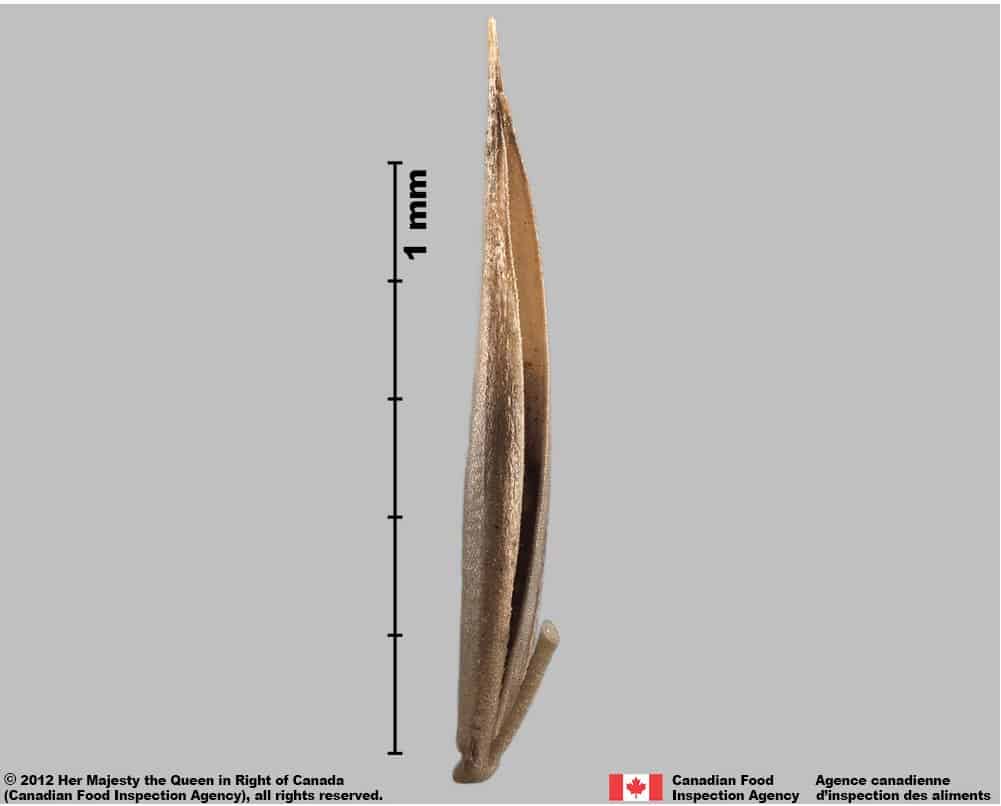
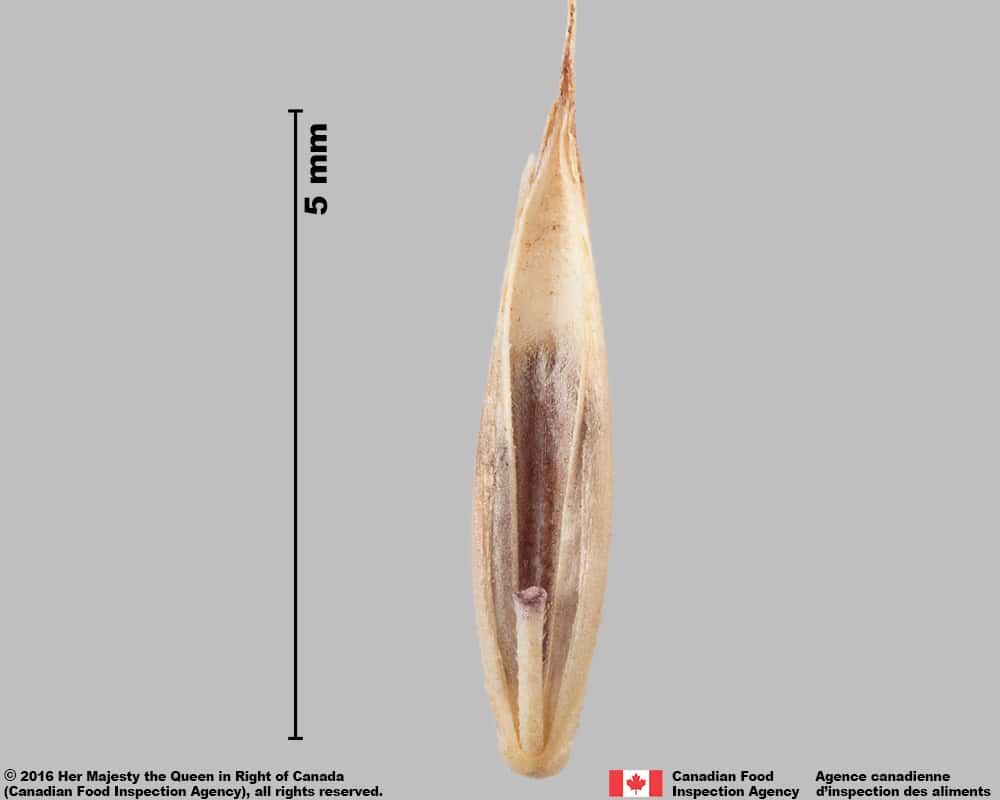
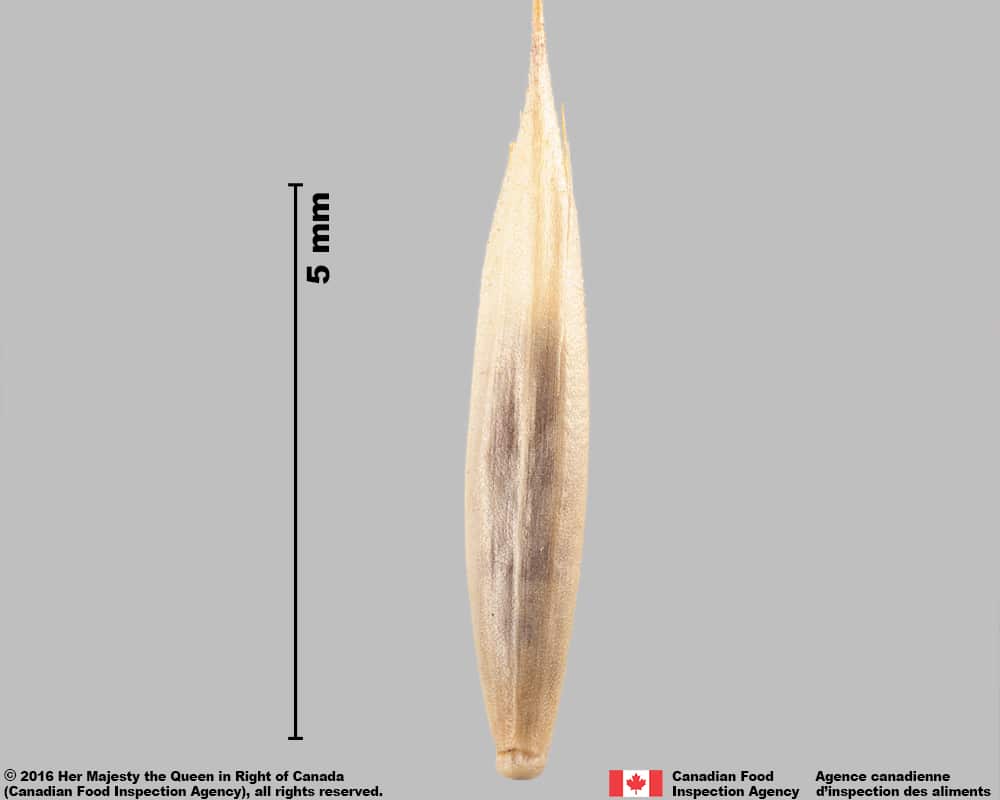
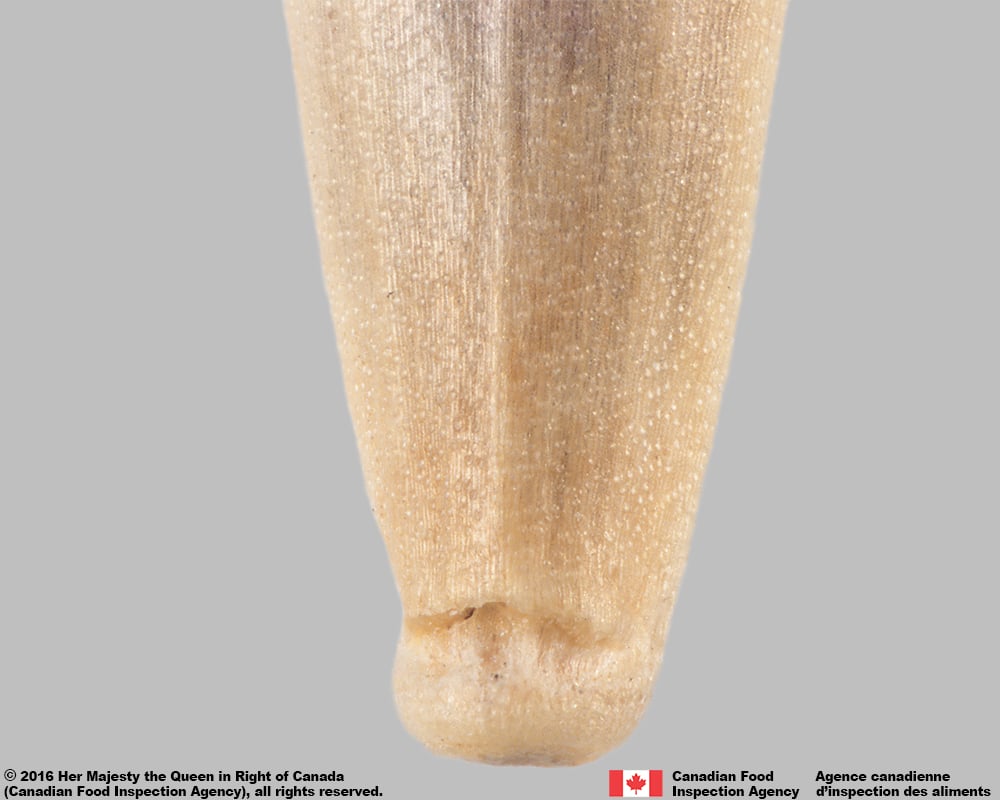
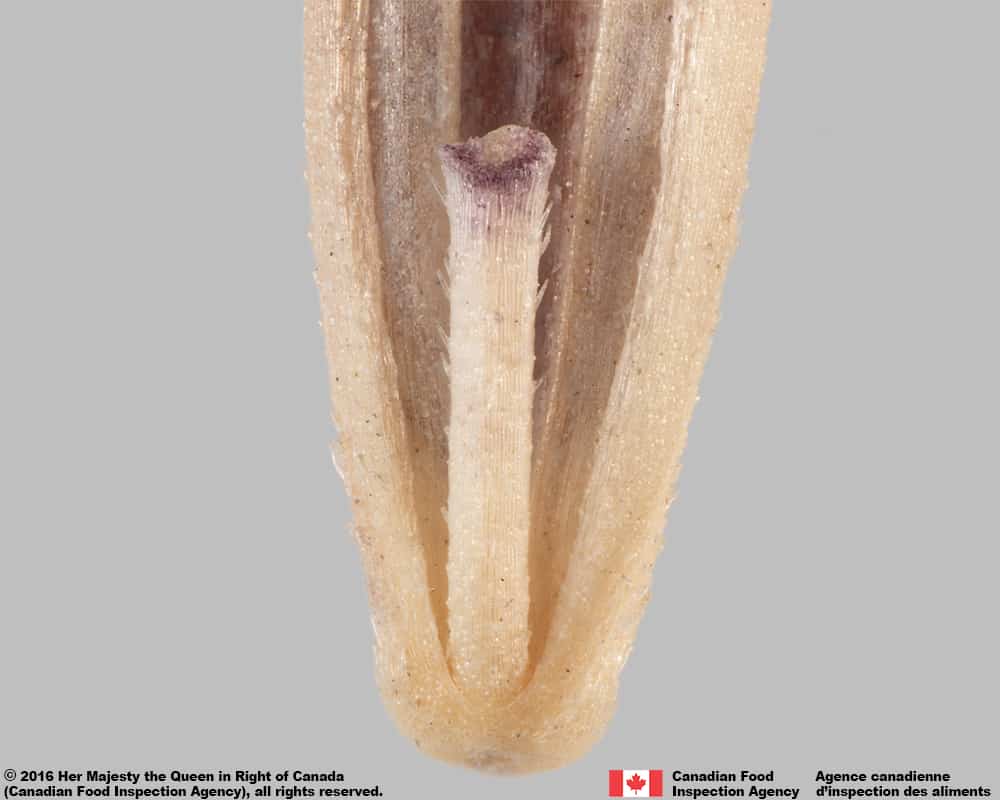
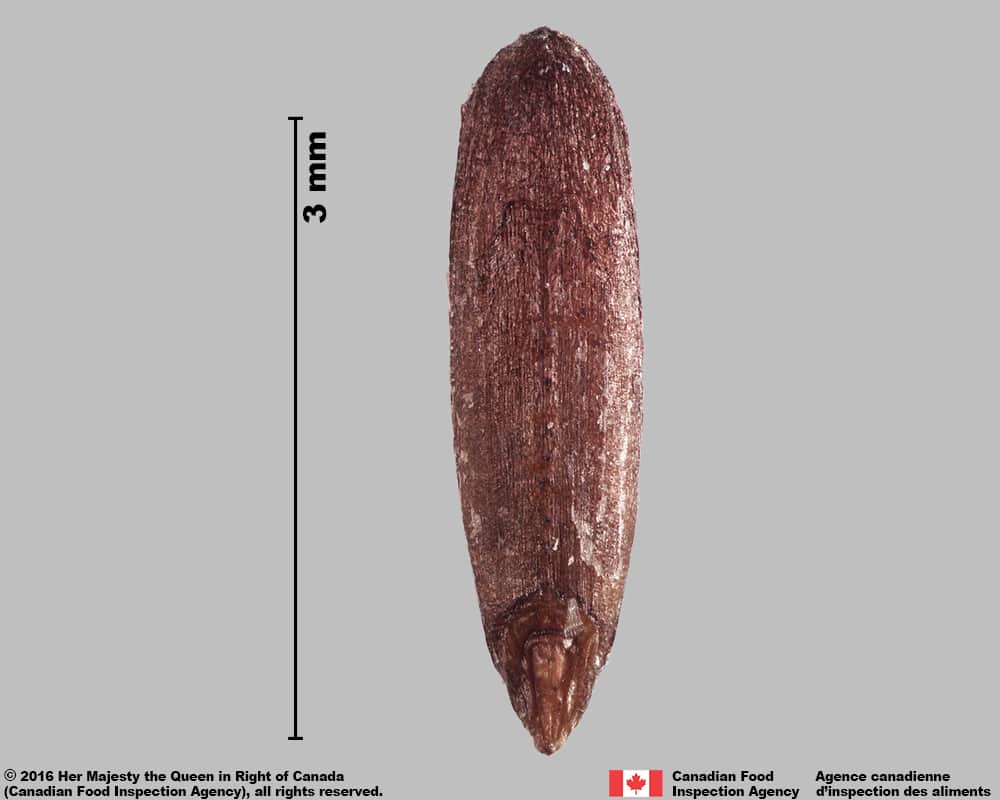
-
Caryopsis
Size
- Caryopsis length*: 2.9 – 4.1 mm (average 3.3 mm); caryopsis width: 0.8 – 1.0 mm) (average 0.9 mm).
- Hilum length*: 2.0 – 3.1 mm (average 2.5 mm).
Note:* Minimum and maximum of caryopsis and hilum based on nine caryopses in a normal range of this species using image measurement protocol (ISMA 2020). CDA-S-23411
Shape
- The caryopsis is narrowly oblong, oval, or egg-shaped, dorsal-ventrally compressed, slightly in-rolled forming a longitudinal groove on the hilum side.
Surface Texture
- Caryopsis surface is smooth to slightly rough, dull to shiny, lemma and/or palea may be adherent.
- Apex of caryopsis without hairs
Colour
- Caryopsis is pale to dark reddish-brown coloured, sometimes with purplish tinge.
Other Features
- The hilum is linear, about three-fourths the length of caryopsis, and located in a longitudinal depression.

Festuca rubra subsp. rubra caryopsis, embryo view

-
Embryo
Size
- Embryo length*: 0.5 – 0.7 mm (average 0.6 mm).
- The embryo is about one-fifth to one-sixth the length of caryopsis.
Note:* Minimum and maximum of embryo length based on nine caryopses in a normal range of this species using image measurement protocol (ISMA 2020). CDA-S-23411
Shape
- Embryo shape is oval to teardrop shaped.
Endosperm
- Endosperm solid (Terrell 1971).
Other Features
- Embryo position lateral (Martin 1946).

Festuca rubra subsp. rubra caryopsis, embryo view

Identification Tips
CONSEILS POUR L’IDENTIFICATION
Florets of Festuca rubra are similar to those of other fine-leaved Festuca species sold commercially for lawn, turf, and erosion control. Caution should be used when attempting to identify florets and caryopses from commercial seed lots as many diagnostic features may be damaged or removed during seed conditioning. General characteristics of this group of Festuca species are discussed in the similar species section of this factsheet.
In commercial seed mixtures of Festuca rubra and Festuca arundinacea, large florets of F. rubra and small florets of F. arundinacea overlap in size but can be separated based on the roughness of the lemma of F. arundinacea and the tuft of hairs located at the tip of the palea of F. rubra, which is lacking in F. arundinacea.
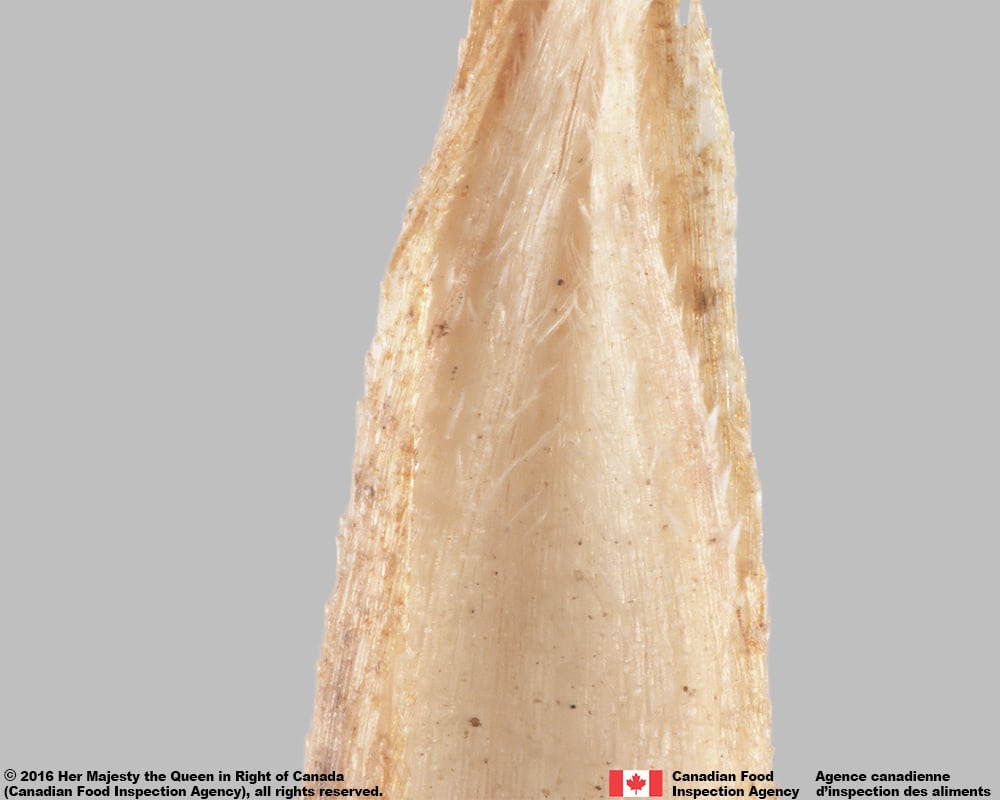
Festuca rubra subsp. rubra floret, palea (close-up view)







Additional Botany Information
AUTRES RENSEIGNEMENTS BOTANIQUES
Flowers/Inflorescence
- The inflorescence an open panicle, 4 – 14 cm long (Tutin et al. 1980).
- Anther length: 2 – 3.5 mm (eFloras 2022).
- Ovary apex without hairs (Barkworth et al 2007).
Vegetative Features
- Rhizomatous and loosely tufted plants, with several stems arising from the same plant tuft, up to 110 cm tall, smooth (Tutin et al. 1980; Barkworth et al. 2007; Bojňanský and Fargašová 2007).
- Young leaf sheaths fused for about three-quarters of their length, smooth or hairy, reddish in colour, older sheaths of vegetative shoots shredding into fibers (Barkworth et al. 2007).
Similar Species
ESPÈCES SEMBLABLES
Similar species are based on a study of seed morphology of various species, and those with similar dispersal units are identified. The study is limited by physical specimen and literature availability at the time of examination, and possibly impacted by the subjectivity of the authors based on their knowledge and experience. Providing similar species information for seed identification is to make users aware of similarities that could possibly result in misidentification.
Florets and caryopses of taxa included here have many similar morphological features, some of which can make them indistinguishable.
The general floret shape among all the similar species is narrowly teardrop-shaped (lanceolate), dorsal-ventrally compressed and slightly in-rolled on the palea side; the lemma tapers to a narrow point that usually extends into an awn. The awn is fragile and easily broken, especially in commercial seed lots so florets may appear to be awnless; however, Festuca filiformis is naturally awnless or very short awned. The lemma wraps around to cover the margins of the palea, but usually leaves the palea keels exposed. Floret sizes within the spikelet are usually larger near the base of the spikelet and get smaller toward the tip of the spikelet. Floret size ranges among the similar species overlap; however, F. rubra and F. heterophylla tend to be longer and wider than florets of F. ovina and F. trachyphylla, and florets of F. filiformis are the smallest in this group.
The papery lemmas and paleas are about the same colour among the similar species as they are represented by various shades of yellowish-brown and are sometimes tinged with purple or green shading. The lemmas can be smooth to hairy.
For this group of species, the palea is nearly equal in length to the lemma, the two palea keels are in-rolled, and the central part of the palea is recessed in the lower half. The palea is a bit more translucent than the lemma and the dark caryopsis is visible through the palea in mature florets.
The caryopses within this group of similar species are narrowly oblong-oval and pointed at the embryo end, dorsal-ventrally compressed and slightly in-rolled forming a longitudinal groove on the hilum side. The exception is F. filiformis, in which the caryopses are generally oval in outline. Surface texture of the caryopses are smooth to slightly rough, dull to slightly shiny. The tip of the caryopsis (end opposite the embryo) is not hairy, except in F. heterophylla the tip of the caryopsis is hairy. The embryo is about one-fifth the length of the caryopsis and is in the lateral position (Martin 1946). The hilum is long and linear and about three-fourths the length of the caryopsis but is slightly longer in F. filiformis. The endosperm is described as solid (Terrell 1971).
The separation of similar looking seeds of Festuca rubra and F. ovina may be achieved by the root fluorescence test, in which young seedlings are sprayed with an ammonia solution and roots of F. rubra will appear yellow-green and roots of F. ovina will appear bluish green under ultraviolet light (ISTA 2022). Separation of F. rubra and F. trachyphylla seedlings may be similarly achieved based on seedling root fluorescence (AOSA 2009).
Refer to the comparison chart for morphological differences among the similar species. The size measurements provided in the comparison table are based on seed herbarium material located at the California Department of Food and Agriculture (specimens accession numbers are provided for each species).
Festuca filiformis Pourr.
[Festuca capillata Lam.; F. tenuifolia Sibth.]
Hair fescue, fine-leaf sheep fescue, fine-leaved fescue, slender fescue
*Notes: minimum and maximum sizes are based on 12 florets and five caryopses in a normal range of this species using image measurement protocol (ISMA 2020). CDA-S-23358.
Festuca heterophylla Lam.
[Festuca rubra L. var. heterphylla (Lam.) Mutel]
Various-leaved fescue, shade fescue
*Notes: minimum and maximum sizes are based on 13 florets and one caryopsis in a normal range of this species using image measurement protocol (ISMA 2020). CDA-S-23305.
Festuca ovina L.
Sheep fescue
*Notes: minimum and maximum sizes are based on 10 florets and eight caryopses in a normal range of this species using image measurement protocol (ISMA 2020). CDA-S-23351, CDA-S-23357.
Festuca rubra L. subsp. commutata Markgr.-Dann.
[Festuca nigrescens Lam.; Festuca rubra L. subsp. fallax auct.]
Chewings fescue, Chewing’s fescue
*Notes: minimum and maximum sizes are based on combined five samples with a random selection of 36 florets and 22 caryopses in normal range of this species using image measurement protocol (ISMA 2020). CDA-S-23403, CDA-S-23384, CDA-S-23415
Festuca trachyphylla (Hack.) R. P. Murray
[Festuca brevipila R. Tracey used by CFIA 2021 and F. trachyphylla (Hack.) Krajina used by USDA-AMS 2022]
Hard fescue
*Notes: minimum and maximum sizes are based on 10 florets and 5 caryopses in a normal range of this species using image measurement protocol (ISMA 2020). CDA-S-23326, CDA-S-57398.
| F. rubra subsp. rubra | F. rubra subsp. commutata | F. filiformis | F. heterophylla | F. ovina | F. trachyphylla | |
| Floret length (mm)* | 3.4 – 7.7 | 4.0 – 6.6 | 2.2 – 3.7 | 4.1 – 6.3 | 4.0 – 5.7 | 3.6 – 4.9 |
| Floret width (mm)* | 0.7 – 1.3 | 0.7 – 1.1 | 0.6 – 0.9 | 0.8 – 1.0 | 0.7 – 1.1 | 0.8 – 1.0 |
| Lemma awn length (mm)* | 0.3 – 2.9 | 0.4 – 2.4 | Unawned or very short awn, 0.1 – 0.7 | 0.6 – 2.9 | 1.0 – 4.0 | 0.7 – 2.4 |
| Lemma surface texture | Lemma smooth or covered with short stiff or soft hairs especially in upper half. | Lemma smooth or sparsely hairy. | Lemma usually smooth or with short stiff or soft hairs near tip and along margins. | Lemma usually smooth, sometimes with short hairs near tip or long hairy in the upper two-thirds. | Lemma mostly smooth or with short stiff hairs near tip or sometimes hairy in upper two-thirds. | Lemma usually smooth or with short stiff hairs in upper half, rarely hairy all over. |
| Callus | Blunt with a thick rounded ridge on the lemma side. | Blunt with a thick rounded ridge on the lemma side. | Thin ridge, thicker in the center and appearing slightly curved. | Plump ridge, thicker in the center and appearing slightly curved. | Thick ridge, blunt base. | Thick ridge. |
| Rachilla | Rachilla smooth or covered with short hairs. | Rachilla smooth or covered with short hairs.
|
Rachilla smooth or hairy. | Rachilla smooth or sparsely long hairy. | Rachilla smooth to sparsely long hairy.
|
Rachilla smooth to sparsely long hairy.
|
| Palea | Palea surface granular, tuft of short soft hairs near tip; keel hairs (palea teeth) short and stiff. | Palea surface granular, tuft of short soft hairs near tip; keel hairs (palea teeth) short and stiff. | Palea surface granular, area between the palea keels smooth or with short hairs near the tip; keel hairs (palea teeth) lacking or short and widely spaced. | Palea surface granular, area between palea keels hairy near tip; keel hairs (palea teeth) along upper two-thirds of keels short and stiff and widely spaced. | Palea surface granular, area between palea keels hairy near tip; keel hairs (palea teeth) along upper one-third of keels short and stiff. | Palea surface granular, area between palea keels sparsely hairy in upper third and especially near tip. |
| Caryopsis length (mm)* | 2.9 – 4.1 | 2.4 – 3.8 | 1.6 – 1.9 | 2.9 | 2.1 – 3.1 | 2.5 – 3.8 |
| Caryopsis width (mm)* | 0.8 – 1.0 | 0.6 – 1.0 | 0.7 – 0.8 | 0.6 | 0.5 – 0.7 | 0.8 – 0.9 |
| Caryopsis apex | Caryopsis apex not hairy. | Caryopsis apex not hairy. | Caryopsis apex not hairy. | Caryopsis apex hairy. | Caryopsis apex not hairy. | Caryopsis apex not hairy. |
| Caryopsis other features | Hilum linear, about ¾ the length of caryopsis. | Hilum linear, about ¾ the length of caryopsis. | Hilum linear, about 4/5 the length of caryopsis. | Hilum linear, about ¾ the length of caryopsis. | Hilum linear, about ¾ the length of caryopsis. | Hilum linear, about ¾ the length of caryopsis. |
*Minimum and maximum measurement of structures in a normal range of these species using image measurement protocol (ISMA 2020).
Click to select species
Cliquez pour sélectionner les espèces
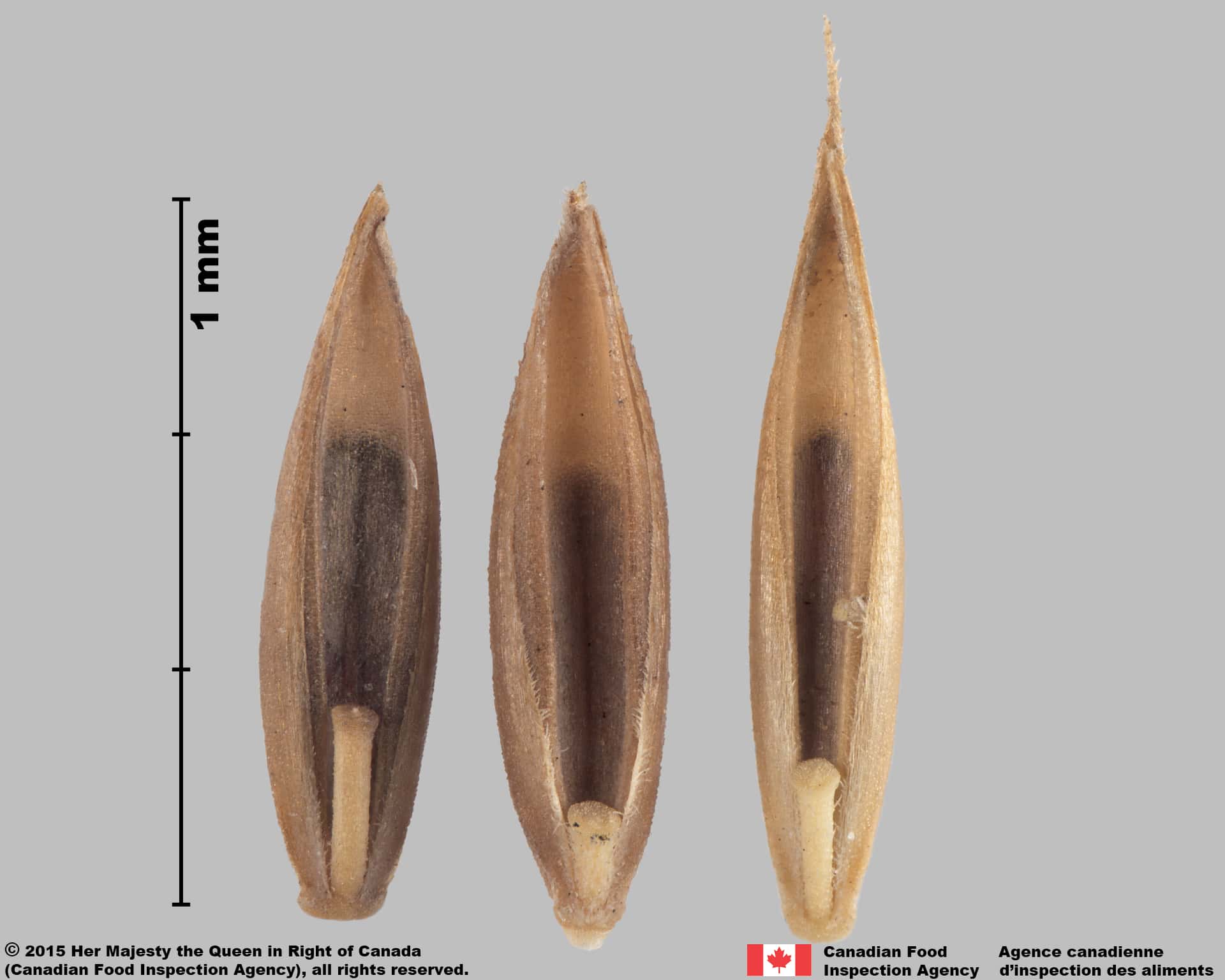
Festuca filiformis
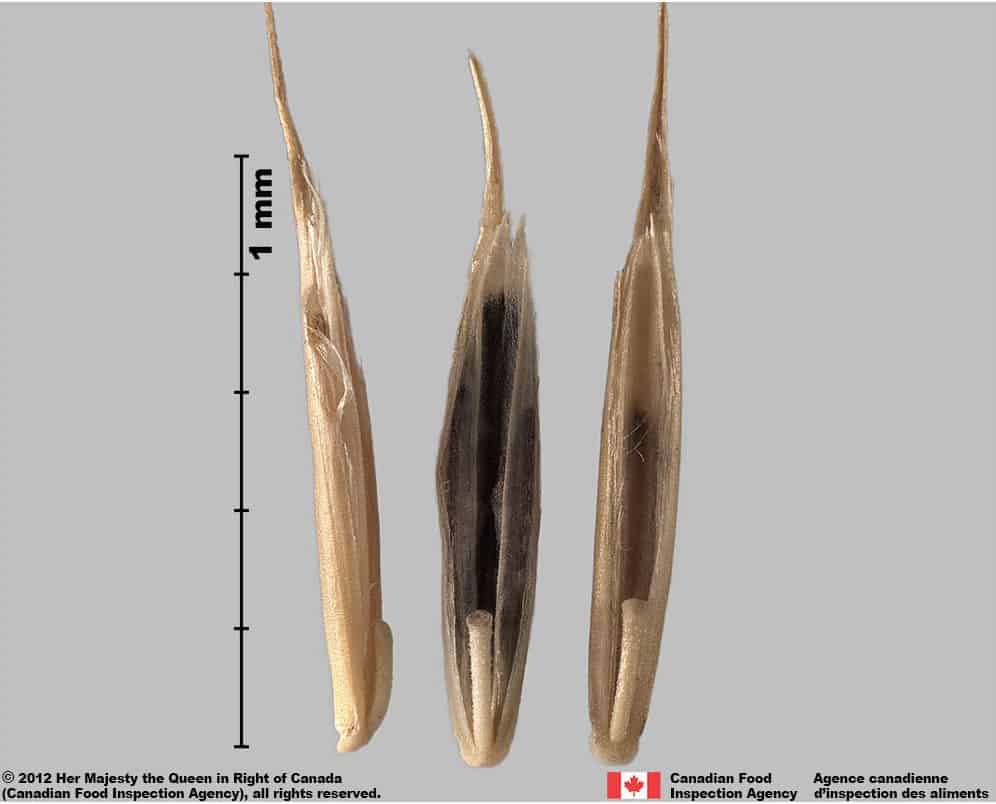
Festuca heterophylla
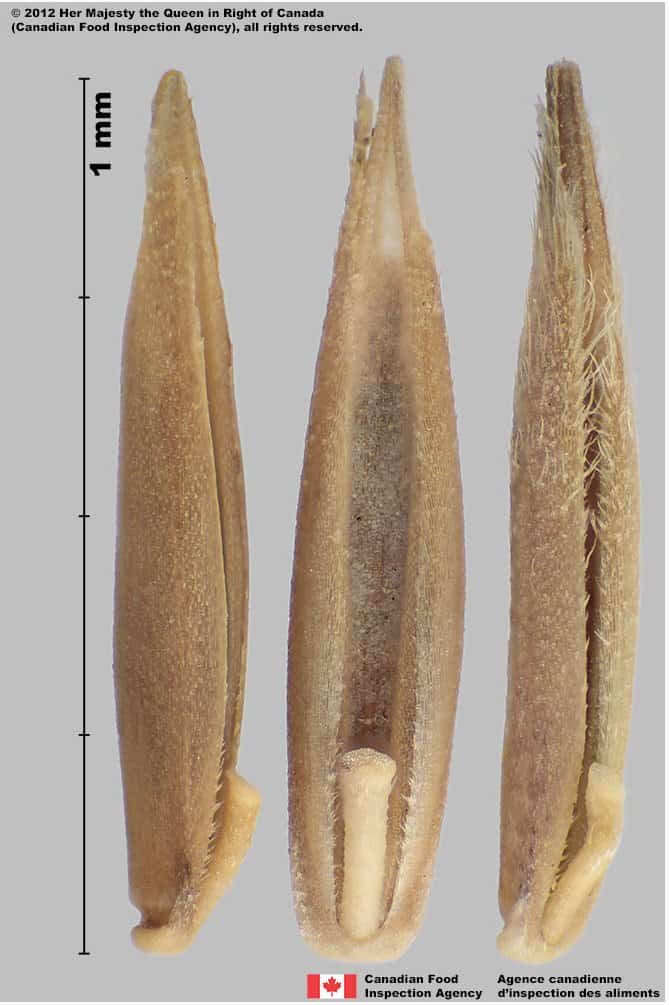
Festuca ovina
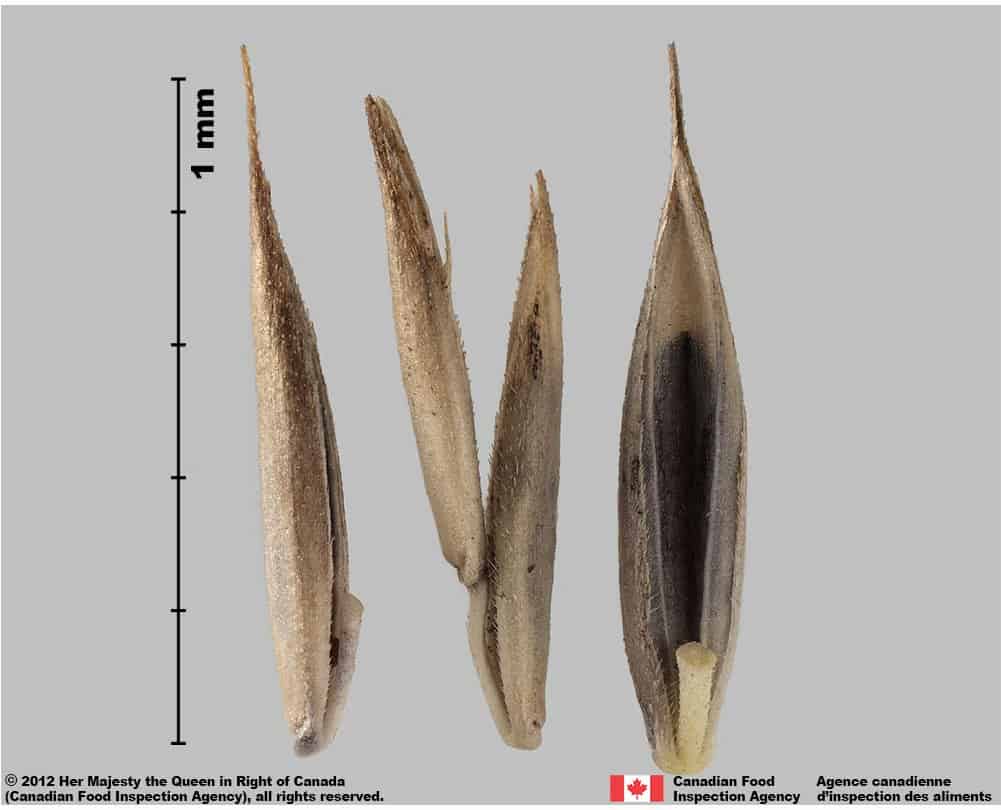
Festuca rubra subsp. commutata
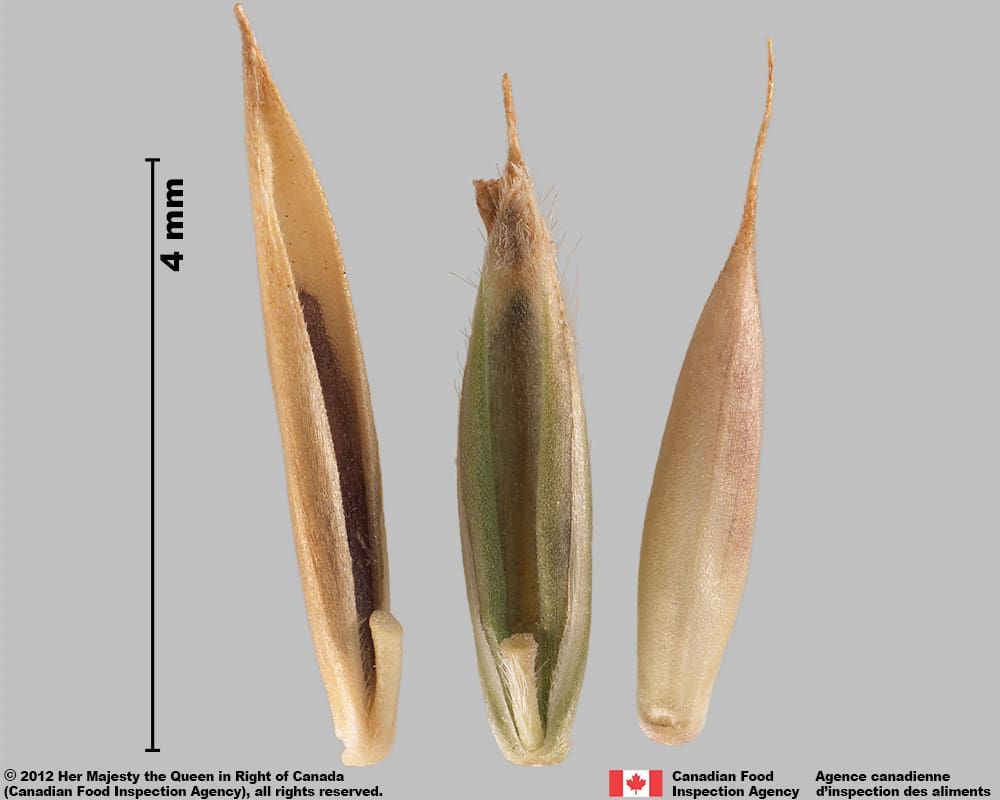
Festuca trachyphylla
Comparison Window
Fenêtre de comparaison
MAIN SPECIES
ESPÈCES PRINCIPALES
Festuca rubra

Festuca rubra
Poaceae
Red fescue (Festuca rubra subsp. rubra) florets
MAIN SPECIES
ESPÈCES PRINCIPALES
Festuca rubra

Festuca rubra
Poaceae
Red fescue (Festuca rubra subsp. rubra) floret, palea view
MAIN SPECIES
ESPÈCES PRINCIPALES
Festuca rubra

Festuca rubra
Poaceae
Red fescue (Festuca rubra subsp. rubra) floret, lemma view
MAIN SPECIES
ESPÈCES PRINCIPALES
Festuca rubra

Festuca rubra
Poaceae
Red fescue (Festuca rubra subsp. rubra) floret, side view
MAIN SPECIES
ESPÈCES PRINCIPALES
Festuca rubra

Festuca rubra
Poaceae
Festuca rubra subsp. rubra floret, base of lemma (close-up view)
MAIN SPECIES
ESPÈCES PRINCIPALES
Festuca rubra

Festuca rubra
Poaceae
Festuca rubra subsp. rubra floret, palea (close-up view)
MAIN SPECIES
ESPÈCES PRINCIPALES
Festuca rubra

Festuca rubra
Poaceae
Festuca rubra subsp. rubra floret, rachilla
MAIN SPECIES
ESPÈCES PRINCIPALES
Festuca rubra

Festuca rubra
Poaceae
Festuca rubra subsp. rubra caryopsis, embryo view
SIMILAR SPECIES
ESPÈCES SEMBLABLES
Festuca filiformis

Festuca filiformis
Poaceae
Festuca filiformis florets, palea view
SIMILAR SPECIES
ESPÈCES SEMBLABLES
Festuca filiformis
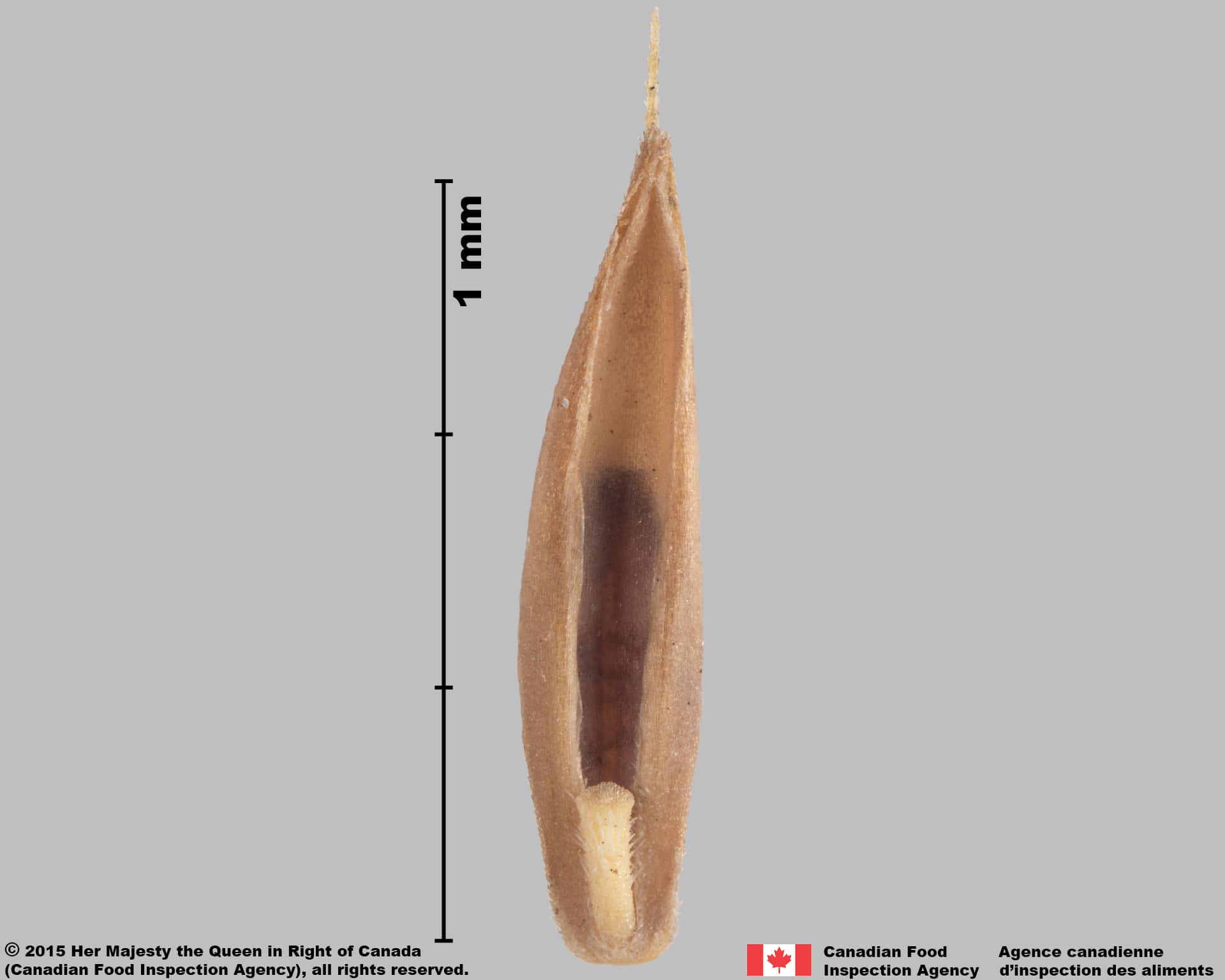
Festuca filiformis
Poaceae
Festuca filiformis floret, palea view
SIMILAR SPECIES
ESPÈCES SEMBLABLES
Festuca filiformis
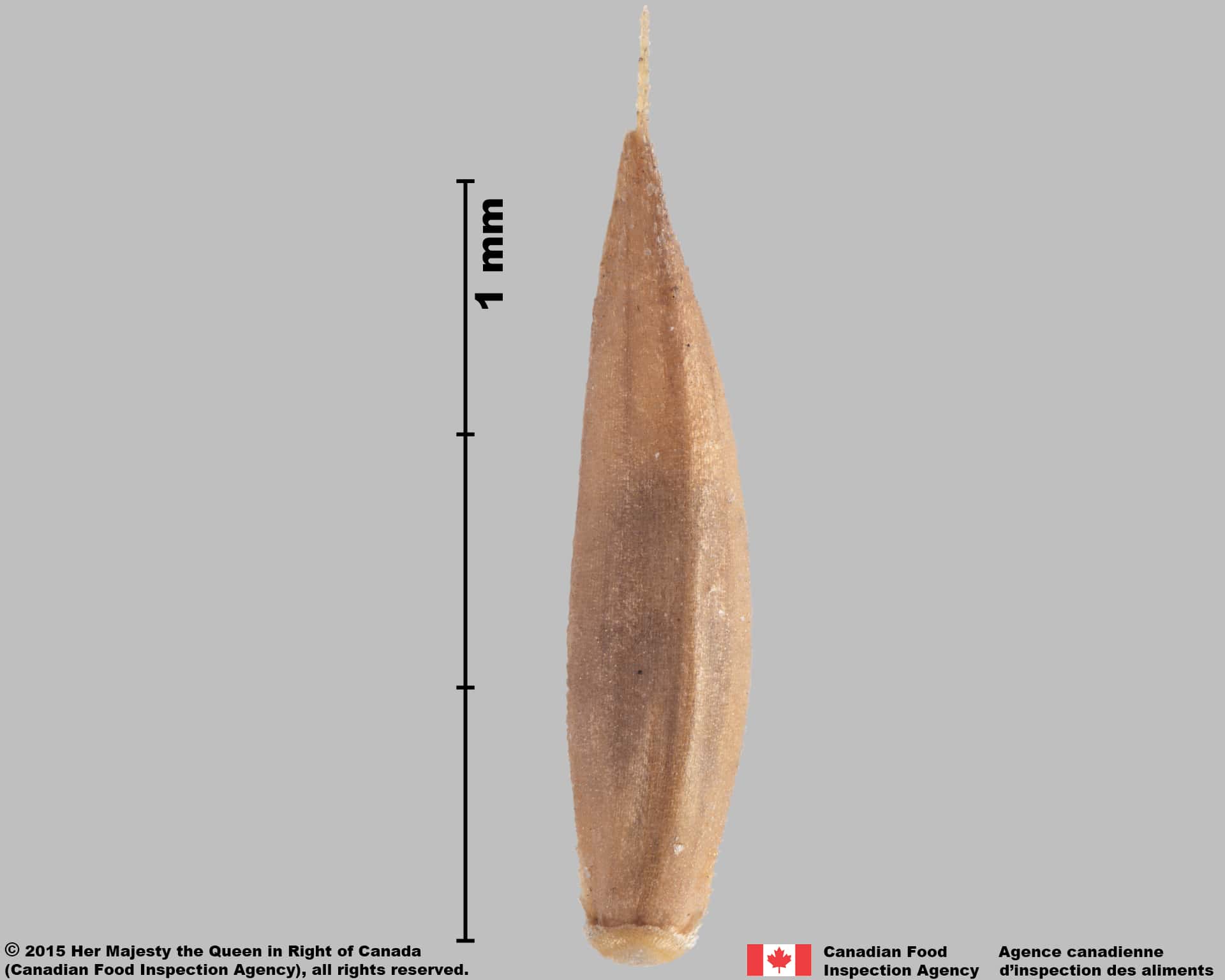
Festuca filiformis
Poaceae
Festuca filiformis floret, lemma view
Need ID Help?
Besoin d’aide pour l’identification?
Reference(s)
Référence(s)
Alderman, S. C., Elias, S. G., Hulting, A. G. 2011. Occurrence and trends of weed seed contaminants in fine fescue seed lots in Oregon. Seed Technology 33(1):7 – 21.
Alderson, J. & W. C. Sharp. 1995. Grass varieties in the United States, U.S.D.A. Agric. Handbook 170, rev. ed. CRC Press.
Association of Official Seed Analysts (AOSA). 2009. Cultivar Purity Testing Handbook: Contribution No. 33 to the Handbook on Seed Testing. Association of Official Seed Analysts.
Association of Official Seed Analysts (AOSA). 2022. Rules for Testing Seeds, Vol. 3: Uniform Classification of Weed and Crop Seeds. Association of Official Seed Analysts, Washington D. C.
Barkworth, M. E., Capels, K. M., Long, S. and Piep, M. B. (eds.). 2007. Flora of North America Volume 24. Magnoliophyta: Commelinidae (in part): Poaceae, part 1. Oxford University Press, New York, New York.
Bojňanský, V. and Fargašová, A. 2007. Atlas of Seeds and Fruits of Central and East-European Flora: The Carpathian Mountains Region. Springer, Dordrecht, The Netherlands.
Braun, R. C., Patton, A. J., Watkins, E., Koch, P. L., Anderson, N. P., Bonos, S. A., Brilman, L. A. 2020. Fine fescues: A review of the species, their improvement, production, establishment, and management. Crop Science 60:1142-1187. DOI:10.1002/csc2.20122
Canadian Food Inspection Agency (CFIA). 2021. Canadian Methods and Procedures for Testing Seeds (M&P). Version 1.1, English. Canadian Food Inspection Agency.
eFloras. 2022. Flora of China. Festuca rubra. efloras.org Accessed May 23, 2022.
International Seed Morphology Association (ISMA). 2020. Method for seed size measurement. Version 1.0. ISMA Publication Guide. https://www.idseed.org/authors/details/method_for_seed_size_measurement.html.
International Seed Testing Association (ISTA). 2022. International Rules for Seed Testing. International Seed Testing Association. Bassersdorf, Switzerland. https://doi.org/10.15258/istarules.2022.F
Martin, A. C. 1946. The comparative internal morphology of seeds. The American Midland Naturalist 36(3):513-660.
Musil, A. F. 1963. Identification of Crop and Weed Seeds. Agriculture Handbook No. 219. U. S. Department of Agriculture. Washington, D C.
Terrell, E. E. 1971. Survey of occurrences of liquid or soft endosperm in grass genera. Bull. Torr. Botan. Club 98(5):264-268.
Tutin, T. G., Haywood, V. H., Burges, N. A., Moore, D. M., Valentine, D. H., Waters, S. M., Webb, D. A. (Eds.). 1980. Flora Europaea. Volume 5: Alismataceae to Orchidaceae (Monocotyledons). Cambridge University Press.
United States Department of Agriculture-Agricultural Marketing Service (USDA-AMS). 2022. Federal Seed Act Regulations. https://www.ecfr.gov/current/title-7/subtitle-B/chapter-I/subchapter-K/part-201 Accessed November 10, 2022.
United States Department of Agriculture-Agricultural Research Service-National Plant Germplasm System (USDA-ARS). 2022. Germplasm Resources Information Network (GRIN Taxonomy). National Germplasm Resources Laboratory, Beltsville, Maryland. URL: https://npgsweb.ars-grin.gov/gringlobal/taxon/taxonomydetail?id=300215 Accessed May 23, 2022.
Wiersema, J. H. and León, B. 1999. World Economic Plants: A Standard Reference. CRC Press, Boca Raton, FL.



